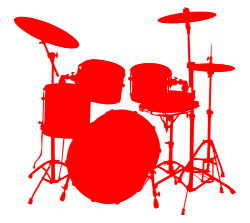Today we’re going to talk about two essential brush beats for the drum set. This is going to be especially relevant for jazz drummers. It could also be useful for drummers wanting to play theater shows or cruise ships, and perhaps military bands as well.
Ballad Brush Beat
The first beat is what many band leaders refer to as “stirring the soup.” You’re basically creating circles on the drum head in a stirring motion. For this beat, you move the hands together in an outward, “swimming” type motion.
It’s difficult to describe in words, so watch the video demonstrating the beat.
The important thing about this beat is that you create a pulse while you’re playing it. This makes the music groove. It gives the band something to play off of.
Practice playing the basic beat and then start experimenting with it. You can create various rhythms as you’re playing the circles, by simply changing the speed and the angle of the brush where ever you want to articulate the beat.
This beat is perfect for ballads. It can also be used for slow to medium tempos. Normally when you play this brush beat you don’t lift the brushes off the head. However, you can lift them sometimes if you need more volume, especially when playing with a big band.
Swing Beat
The second beat is a basic swing beat. This is appropriate for medium and faster tempos.
In this brush beat, the right hand plays the swing rhythm. It starts on the right side of the drum head on 1 and 3. You hit the left side of the drum head on 2 and 4.
The left hand moves in a swishing motion back and forth across the drum head. It starts on the left hand side
of the drum head on 1 and 3. It reaches the right hand side on 2 and 4.
The left and right hands move in opposite directions. This is important because it actually makes the coordination easier.
Again, this is very difficult to explain in writing. Watch the video for a thorough demonstration of each brush beat.
Other Drum Brush Tips
There are several things I want to say about playing with drum brushes. First of all I play a lot of traditional grip with brushes. But it works just as well with the matched grip. So don’t get hung up on that. If you play matched grip just play matched grip with brushes. It doesn’t really make any difference.
The other thing is that I personally turn my snares off when I play with drum brushes. That’s what I’ve always preferred. Some drummers have different preferences, so you should experiment and see what you like. To me, playing with the snares off gives you a more subtle sound. With the snares on it’s going to sound a little different so experiment for yourself and see what you personally like.
I should also mention that I’m using wire brushes. I do like the sound of wire brushes The one problem you will find with wire brushes is they sometimes get caught on the rim. They get bent and there’s really nothing you can do about it, other than take a pair of wire cutters and cut off the bent wires. They’re not going to sound any different if you lose one or two wires. When you lose too many then you need to replace them. But if you take good care of your brushes your brushes will last a long long time. So it’s nothing to be too concerned about.
Brush Beat Summary
Most jazz drummers use variations of these 2 patterns quite a bit in their playing. They probably use a few others as well, but these two are the essential brush patterns.
Years ago, at one of his gigs, I asked Tommy Ruskin if I could come to his house for a brush lesson. Tommy was one of Kansas City’s best jazz drummers, and I loved the way he played with brushes. He simply took me over to a drum case, and basically demonstrated the two patterns I just demonstrated in the video. He said that these were basically the only brush beats he ever used.
I came to the conclusion that day, that it wasn’t necessarily important to know 50 different drum brush beats. What was important ultimately was what you did with those beats.
I actually did not learn these beats from Tommy Ruskin. What he did was kind of confirm that I already knew the basic beats, and that I just needed to continue developing my style of playing with them.
I learned these beats originally from a book by Ed Thigpen, called The Sound Of Brushes. Thigpen was a drummer with The Oscar Peterson Trio. It’s a great book, and one I’d recommend, if you want a more in depth study of brushes. Here is the link to the book at Amazon.com.
Note: I may receive a commission from Amazon when you click on one of my links to make a purchase. This however, has no bearing on my reviews and comparisons. I make no recommendations on any products that I don’t personally use myself. And there is absolutely no mark up here. You pay the exact price from the merchant I recommend that you would otherwise. Purchasing through these links help pay to keep this site afloat. 😀 Thank you for your help!
